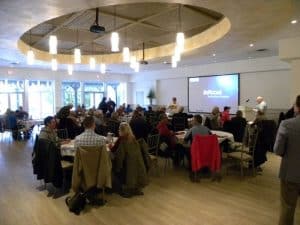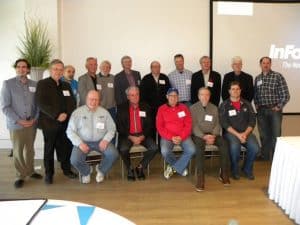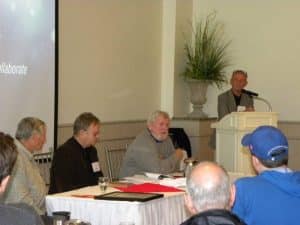Canadian Baseball History Symposium 2017
 The second annual Canadian Baseball History Symposium will be held on November 18th and 19th, 2017, in St Marys, Ontario, home of the Canadian Baseball Hall of Fame and Museum. Join Canadian baseball historians for one and a half days of research presentations covering any and all aspects of Canada’s rich baseball history. Learn about 19th-century player Bob Addy and manager William Watkins, baseball and Canadian soldiers in World War I, baseball and entertainment, the completion of the Chatham Coloured All-Stars project, and much more.
The second annual Canadian Baseball History Symposium will be held on November 18th and 19th, 2017, in St Marys, Ontario, home of the Canadian Baseball Hall of Fame and Museum. Join Canadian baseball historians for one and a half days of research presentations covering any and all aspects of Canada’s rich baseball history. Learn about 19th-century player Bob Addy and manager William Watkins, baseball and Canadian soldiers in World War I, baseball and entertainment, the completion of the Chatham Coloured All-Stars project, and much more.
Participate in a pictorial history quiz based on images spanning the period 1871 to the present. Listen to two of Canada’s most respected baseball writers (Bill Humber and 2016 Jack Graney Award winner Larry Millson) discuss what defines being Canadian, and the consequences of that definition for historical research.
When: Saturday, November 18th, 8AM – 5PM and Sunday, November 19th, 8AM-12:30 PM
Where: St. Marys Golf & Country Club, 769 Queen St. E., St. Marys, Ont.
Registration cost for the event is $60. To register, please send an E-transfer to [email protected], or a cheque made out to Andrew North to: 398 Queen St. E., P.O. Box 3305, St. Marys, Ont. N4X 0A6
Prospective attendees looking for overnight accommodation in St. Marys in November might consider these options:
- For B&B-style rooms: http://www.townofstmarys.com/en/discover-our-town/Accommodations.aspx.
- The Westover Inn at westoverinn.com. This is where Christopher Plummer elected to stay when he was performing at the nearby Stratford Festival. We’ve been quoted a rate of $89 per night for a standard room, and $159 per night for a “Superior Room”, plus taxes. You must cite the Canadian Baseball History Symposium when registering to get this rate.
- The Stone Willow Inn at stonewillow.com. This offers large rooms (suitable for sharing), and is across the street from our conference venue. We’ve been quoted these rates: $120/night for a standard double queen, $145/night for a balcony room, $160/night for a king, and $180/night for an executive suite. Taxes extra in all cases. A 2-night stay in a standard double queen would amount to $271.20 all in. Again, you must cite the conference to get these rates.
Summary of Presentations
 Jerry Amernic: Babe Ruth and His Canadian Connections
Jerry Amernic: Babe Ruth and His Canadian Connections
My research on Babe Ruth began with my first novel Gift of the Bambino in which he was a character. In the years since then I have found lots of new things about him, and that includes his numerous connections to Canada. This presentation will look at those connections, some of which are not well known, and will also shed light on a few tidbits about Ruth that made him a man who was ahead of his time, and not just on the baseball field. This material is all going into a new book about the legacy of Babe Ruth that will be released in Spring 2018. Ruth’s grandson is writing the Foreword and the family is releasing photos that have not been in the public domain.
Robert K. Barney and Barbara Weis: A Further Nail in Doubleday’s Coffin: Johann Friedrich GutsMuths and the Diffusion of ‘Base-Ball’ to Europe, 1796
If one were to sample Americans on the question of “who invented the game of baseball”, 75% of them would answer “Abner Doubleday”, so powerful and longstanding has that now well-disproved myth been embedded in American history. In denouncing the Doubleday “immaculate conception” origin of baseball, we now know that the fundamentals of the game were part and parcel of an English children’s pastime dating back to at least the 17th century (1600s), long before the standard Doubleday date of 1839, some two centuries later. We know also that by the 18th century (1700s) the rudiments of that children’s game diffused westward to colonial North America in the cultural baggage of British youngsters, where the game, over two centuries advanced, evolved from children’s play to local adult male contests, to inter-town competition, to amateur/professional leagues, and to international play at the highest levels (World Series, Olympics, World Classic). But what about base-ball’s diffusion eastward from Britain, to continental Europe? To answer this question at the point of its earliest evidence, we turn to a long neglected literary piece that not only provides a fundamental answer to the question posed above, but also renders further evidence to the body of knowledge that helps to destroy the well-founded but nevertheless salacious Doubleday myth. Thus, we offer an analysis of a portion of Johann Friedrich GutsMuth’s 1786 German publication Gymnastik für Die Jugend (Gymnastics for Youth), in which the author describes the English children’s game of ”base-ball” as a suitable playground activity for 18th century German youth.
John Cairney: A brief history of the 3-pitch inning in Major League Baseball
In writing and speaking about my research on the immaculate inning, I was often questioned about the definition of 9 strikes to retire the side as a benchmark for perfection. The most common question was why a 3-pitch inning was not considered immaculate? Interestingly, while the 3-pitch inning is also rare, it does not have a name, nor is it a topic of conversation in the game the way the immaculate inning has become in recent years. With the intent of shedding more light on this remarkable occurrence (much the same way I tried to do with the immaculate inning), I will review the history of the 3-pitch inning dating back to the late 1800s. In particular, I will showcase Canadian connections to the achievement: for example, Halladay and Key are the only Blue Jays pitchers to be involved in a 3-pitch inning; Montreal’s Steve Kline and Felipe Lira are also part of the record. The 3-pitch inning continues my exploration of perfection in a game that defies it.
Warren Campbell: Baseball and Entertainment
We give a brief synopsis of the history of baseball players in Vaudeville and Hollywood. From Rube Waddell wrestling with alligators to Babe Ruth singing, baseball players have always found a way for a second income and increased exposure in the entertainment field. We’ll explore a bit of this early history then show video excerpts from when major league baseball came north. National Film Board clips will be shown from the four baseball documentaries they have produced since 1953, as will examples of the many Montreal Expos and Toronto Blue Jays players who have appeared in commercials, with varying results.
Stephen Dame: Canadian Baseball During the Great War
Just over a century ago, when Canadian boys volunteered, suited up and shipped out for their baptism by fire, they brought with them their favourite game: baseball. What began as a distraction for idle soldiers grew into a government sponsored recreation which begat multiple leagues, international championships and a burgeoning baseball culture across Flanders and the United Kingdom. Baseball mad members of the Canadian Expeditionary Force, including a young airman named Lester Bowles Pearson, played before Royalty, drew crowds of over 70,000 and claimed titles over their American doughboy counterparts. Tom Longboat, Ban Johnson, Arthur Currie, Prime Minister Robert Borden, King George V and Princess Patricia were all linked by the northern national pastime during wartime. As Canada came of age during the First World War, it did so with bayonets, bats, guns and ball gloves. The greatest game was an invaluable part of Canada’s Great War experience.
Bill Humber: The First! Introducing the Mercurial, Malicious, and Masterly World of Robert “Bob” Addy
Bob Addy is the lost soul of Canadian baseball history. I confess that even I, author of several books on the topic, make no reference to him. He’s been hiding in plain sight but it took SABR sleuth Peter Morris to recently confirm Addy’s Canadian identity, his Port Hope birth and upbringing, and the roots of the tinsmith profession he never abandoned.
I’ll focus on those Port Hope and Canadian connections. New discoveries confirm his place in a box score submitted to the New York Clipper in 1861, as well as his apparently lost cricket history in Canada. I’ll show how Addy’s probable childhood play has links to the first recording of a game called “ball” in this part of Upper Canada in the first decade of the 19th century, and what his continuing connection to Port Hope throughout the rest of his life might mean for a greater understanding of this complex but major figure in early baseball history. Finally I’ll consider whether he was running from a Canadian past or perhaps something more sinister, hinted at, but not fully explored, by Peter Morris.
Martin Lacoste: The Drive of ‘85 – The 1885 Canadian League
The first fully Canadian baseball league to play out a full season was the 1885 Canadian League. This presentation reviews the season from beginning to end, including: its formation and the driving forces behind it; the five teams involved and their managers; game highlights and season standings; the players – their origins, the league leaders, plus an overview of the 30+ players who were or became Major Leaguers; and the end of the season and why the league did not return in 1886.
Chip Martin: William Watkins and the Detroit Wolverines
A native of Brantford, Ontario, William Henry Watkins is the most successful Canadian baseball manager of all time. He played his first competitive baseball with the Guelph Maple Leafs, which he also managed, in 1880. As an infielder for the Indianapolis Hoosiers of the American Association, he was nearly killed when struck by a pitch in 1884 and after recovering, switched from playing to managing. He managed the Hoosiers for the rest of the season, and in 1885 moved with several of his players to the Detroit Wolverines when Indianapolis disbanded. There, he found great success, leading the National League club to a second place finish in 1886. The following year, Detroit captured the pennant and defeated the St. Louis Browns in the “world’s series,” 10 games to 5.
Watkins also managed the St. Louis Browns and Pittsburgh Pirates of the National League, and Kansas City of the American Association. His major league record was 452-444. Overall, teams he managed collected seven pennants, in the National League, Federal League, Western League, Western Association and Michigan State League. He spent most of his 42-year baseball career in Indianapolis and made his home in Port Huron, Michigan, where he died in 1937 at the age of 79.
David Matchett: What is a Canadian?
This is a seemingly simple question, but it isn’t, and it comes up while researching the history of baseball in Canada. Some players who were born in Canada emigrated soon thereafter and others born abroad moved to Canada before they could walk. Ongoing research can uncover an old census record that converts an American or removes someone else from the list of Canadians. And various research resources can differ, especially those in print that can go out of date. The Canadian Baseball History Symposium is in a position to set the definition then maintain and update a list of Canadian major leaguers. Future research projects could be able to clearly state “Canadian players, as defined by the St. Marys Conference…” and we would all know exactly what that means and who is included, or excluded, and why. This presentation is a proposal for some ground rules to start a conversation and lead to a comprehensive list of Canadians that we can all agree upon.
Panel Discussion: What is a Canadian?
Moderator: David Matchett
Panelists: Bill Humber, Larry Millson
Michael Murray: Canadian Baseball Pictorial Quiz
Sharpen your wits and your pencils to participate in a Canadian Baseball History quiz. Questions will be based on photographs from the author’s personal collection, fleshed out with historical detail. Subjects will span the entirety of the professional era, from 1871 to the present. Prizes will be awarded.
Fred Toulch: Montreal Royals Vignettes
The Montreal Royals were one of the most successful minor league baseball teams. Their success was largely due to their close association with the Dodgers – more specifically Branch Rickey and the Brooklyn Dodgers. The team won 9 pennants. During their Dodger affiliation (1939-1960) the Royals won all seven of their Governor’s Cups and three Junior World Series titles, and featured ten of their dozen future Hall of Famers. This presentation will focus on selected lesser-known Royals personnel that were involved in a variety of significant events.
Miriam Wright, Dave Johnston, Heidi Jacobs (University of Windsor): Researching Early Canadian Baseball History: The “Breaking the Colour Barrier: Wilfred “Boomer” Harding & the Chatham Coloured All-Stars” Project
In this presentation, we will talk about the possibilities and challenges of researching early Canadian baseball by discussing the research that went into the “Breaking the Colour Barrier: Wilfred “Boomer” Harding & the Chatham Coloured All-Stars” project. Miriam Wright will talk about how the oral histories were collected and what they contributed to the project. Heidi Jacobs will talk about the challenges and opportunities related to researching baseball through newspapers from 1934. Dave Johnston will talk about how we brought many components together in an interactive website to both preserve this history and make it accessible and engaging.
Bill Young: Last Stop: Baseball’s Mexico-Jumpers Find Redemption in Quebec
In 1946, 22 discontented major leaguers, drawn by promises of great riches and ever greener pastures, bolted to Mexico. By 1948, almost all had returned home, forlorn and out of work. Because everyone had jumped their major-league contracts, excepting Danny Gardella, an angry Commissioner Happy Chandler hit them hard, suspending all from major and minor league baseball for a five-year period. Failure to comply would bring suspension for life. They were left with no place to play. Except in Quebec. The Provincial League was on the upswing, and its bosses cared not a whit about MLB and its restrictions. Anyone who had the ability and wanted to play in Quebec was welcome to join in. Indeed the league actively recruited players from afar and in 1948 four jumpers took advantage of that offer. The next year that number expanded to 11. My goal is to chat about that 1949 Provincial League experience, a year in which the success the former outcasts were enjoying so intimidated the Commissioner that he lifted their suspension almost two years before it was scheduled to end.














